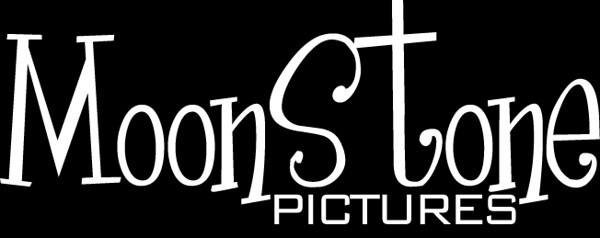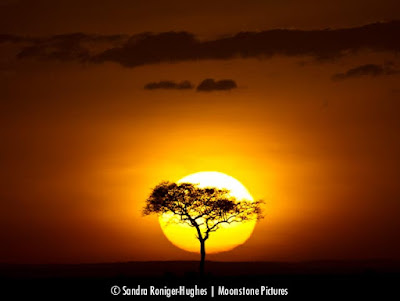BOTSWANA
– SAFARI IN KHWAI IN FEBRUARY
February
2013
My husband and I are keen wildlife photographers, ardent campers and
enjoy traveling to remote places. We
visit the Botswana bush regularly and often return to the Khwai Development
Trust, Magotho Campsites that borders the Moremi Game Reserve. The Magotho campsites are extremely spacious
and private and as the Khwai Development Trust belongs to the Khwai Community,
the money made returns to the Khwai Community.
There are no facilities at the campsites, it is back to basics and one
needs to be totally self sufficient, such has having own water supply, although
we use river water to shower with, own bucket shower, and the ablutions
comprise of one’s spade and toilet roll.
But the serenity of the place is just spectacular.
 |
| Signage to entry of the Khwai Community Campsite |
 |
| Open Bush Bucket Shower in Khwai at our campsite |
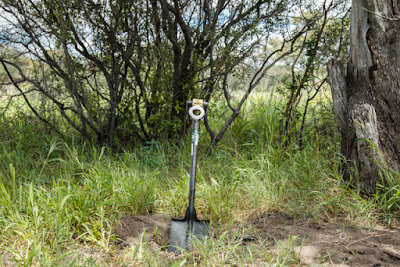 |
| Open Bush Toilet in Kwai
by our campsite |
February 2013, we left Johannesburg at 5:30am en route to Groblers /
Martin’s Drift Border via The Carousel, Kranskop and Nyl Plaza(N11) taking the
R101 to Mokapane, a total of 4 Toll Gates amounting to R89.00 on the South
African side, and finally ending the journey at Khama Rhino Sanctuary, which is
just past Serowe in Botswana. We drive a
Toyota Landcruiser Trooper, which we customized, into a bush photographic
vehicle. We are totally self-sufficient
and the Trooper was loaded with all the camping, photographic equipment and all
other amenities such as food, drinks, water tank etc..and our average speed was
about 100kms per hour. We arrived at the border post at 09:45am and entered
Botswana at 10:30. The Botswana road tax
at the Border was 110.00 Pulas and it is advisable to have some Pulas on you as
this makes the process of paying the road tax a bit faster. Just after the Border the road condition is
not in a good state and full of potholes for a distance of about 10kms and then
the roads are decent, but one must watch out for the cattle on the road. 618kms and 7 hours since departure in
Johannesburg we arrived at Khama Rhino Sanctuary Lodge at 12:30pm.
 |
| Our
safari vehicle customized into a photographic vehicle |
 |
| Self-Catering
chalet at Khama Rhino Sanctuary Lodge |
 |
| White
Rhinos |
We were glad to have left Johannesburg early that morning as this
gave us the whole afternoon to enjoy and drive around the Rhino Sanctuary and
see the most spectacular Rhinos as well as other game around the waterholes such
as Wildebeest, Zebras and various Antelopes.
Our stay was most enjoyable in a self-catering chalet and because we had
an early morning, for opt to have diner at the lodge’s restaurant followed by
an early night. We left Khama the
following morning en route to Maun going through Orapa, Rakops, Motopi and
finally joining up with the A3 that goes directly to Maun, a total of 514kms traveling distance, which took us 5 hours.
There are numerous speed restrictions in Botswana that are often
monitored by the police, so it is best to abide to the speed limit and just
enjoy the ride. In total so far our journey
from Johannesburg to Maun was a total of 1190kms.
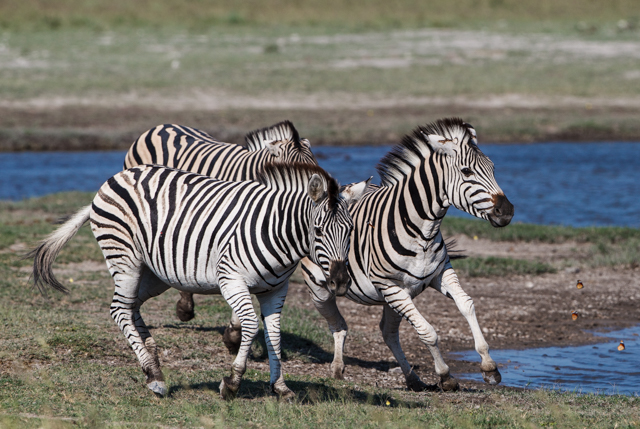 |
| Zebras |
We stayed over in Maun with friends, got some fresh supplies and
finally headed off for Khwai that is 116kms from Maun. After 54kms from Maun, one goes through a checkpoint
or also known as a vet fence, but when going in a northerly direction, in this
case towards Khwai, there are no restriction on food and one is allowed to take
fresh meat and fresh fruits. It is only
when one is going the other way (southerly direction) that no fresh meat and
certain fresh produce are not allowed. After
the checkpoint, the tar road ends and becomes gravel with some good and bad parts. It took us 3 hours traveling time from Maun
to our campsite Khwai.
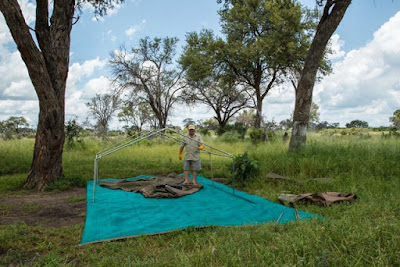 |
| Putting up the tent is the first thing we do on arrival |
 |
| Our
tent is up in our very spacious and private campsite |
 |
| Our
campsite in winter (June 2012) – Summer vs Winter bush |
Although we have been to Khwai numerous times, we have not
experienced Khwai during summer, which we have found to be totally different to
the usual dry sandy campsites as opposed to the long green grass during summer
and abundant river water supply.
Numerous off roads tracks were flooded by the rising Khwai River and
some crossings were rather tricky. One
of the many reasons we enjoy Khwai is that there are no driving restrictions,
as one is allowed to drive off road which allows closer game viewing at any
time during the day or night.
 |
| One
of the water crossings |
 |
| Morning
coffee on the road |
After finishing putting up our tent and setting up camp, we
immediately went on a bush drive and after a successful water crossing, we
continued on to an area where we had seen a pride of lions with cubs the
previous time we were in Khwai, and were hoping to find them again as Lions are
territorial, but we unfortunately got stuck in black sticky sucking mud. Sitting in our vehicle, the path looked a bit
wet but good enough to try it out, however our vehicle just sank in the mud and
the chassis was well glued to the mud!.
What we should have done is to adhere to the rule of always walking the
way first to see if it is fine for the vehicle, especially when traveling
alone!. Luckily not far from our vehicle
was a reasonably strong tree which we tied our winch to it and pulled ourselves
out.
 |
| Our vehicle stuck in the
mud! |
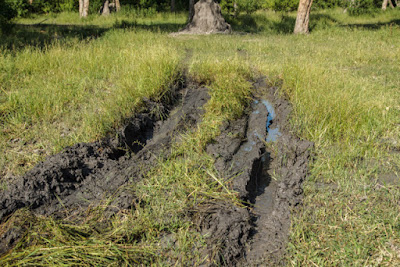 |
| After
getting vehicle out of sticky mud |
Our typical safari day starts around 5:00 in the morning. After a quick splash of water on the face and
teeth brushing we get into our safari vehicle and get underway to find the
game. If we heard lions roaring during
the night we head off in that direction or else we follow game trails and
spoors or we may also choose to go to a waterhole, and hope to find some nice
game viewing. After about 3 hours we
have a little break and enjoy a quick breakfast in the bush before we head off and
carry on our bush drive. We usually
return to our campsite around midday as it is too hot during the day to drive
around and the game is hiding in cool shady places. Whilst at camp we freshen up, have siesta,
download photographs and just chill like the wildlife is doing!. Around 3:00 we head off for our afternoon
game safari with Gin and Tonics loaded in the car for the daily Sundowner at a
scenic spot and we return around 19:00. On return to our campsite, we make a bush fire
and sit around the fire enjoying a relaxing drink whilst listening to the
amazing bush sounds, such as the Jackals and Hyenas calling.
 |
| Getting bush fire ready for bush braai |
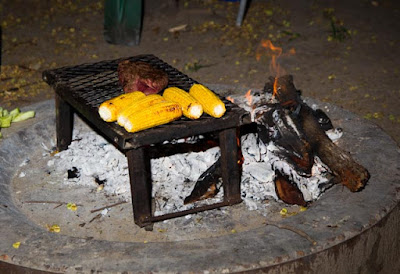 |
Bush Diner, nothing better
like a little piece of fillet and African mielies!
|
We stayed in Khwai for 5 nights and only saw one other occupied
campsite during that time. Unfortunately
due to such long grass and an abundance of water, the game was not as easy to
find as to what we are used to in winter, but we were rewarded with some good
birding. The one night we heard lions
and another night hyenas and found the lions tracks as well as some wild dog
tracks, but we unfortunately did not see them.
We of course saw much antelope such as Impala and Waterbuck and also saw
Warthogs, Hippopotamus, Giraffe and Vervet monkeys. Even the elephants were fewer this time of
the year as usually an elephant is seen around every bend. We did a total of
340kms of Safari driving in Khwai during the 5 days we were there, which for us
is quite a lot of traveling, as we would usually spend much time taking
photographs of game rather than driving.
 |
| European Bee-Eater |
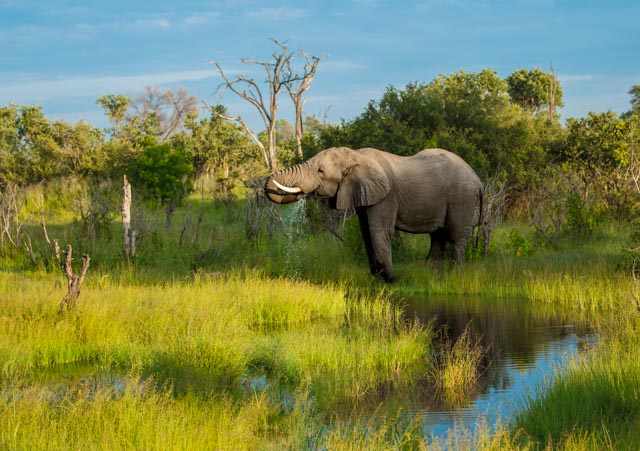 |
| Lone Elephant enjoying an early morning drink |
 |
| Waterbuck amongst the lush
green bush |
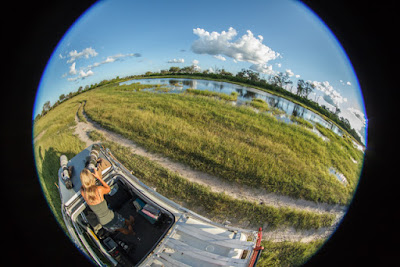 |
| Scenic
view of the Khwai River at sundowner time |
Most late afternoons we stopped by “Hippo Pools” for sundowner drinks
and listened to the wonderful sound of bird calls and Hippopotamuses and
watched the African Jacanas feeding on the edge of the water – it was such a
beautiful surreal moment of just been totally by ourselves in this vast bush, a
cherished experienced in summer Khwai.
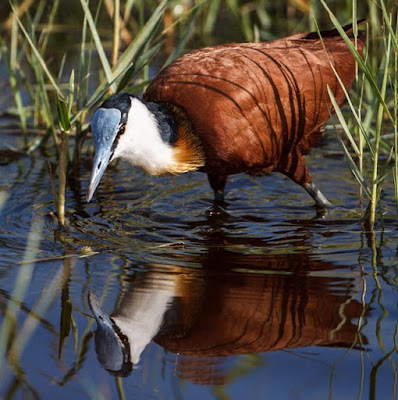 |
| Jacana searching for food |
The colors of the bush are so beautifully lush and green, which gives
really good photography opportunities. However
our favorite is till the winter bush, and that we cannot wait to get to.
Until our next trip…….Ciao for now!
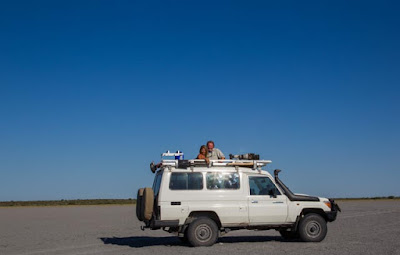 |
| Moonstone Pictures & Safaris |





















